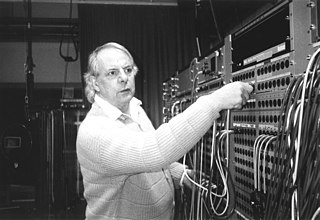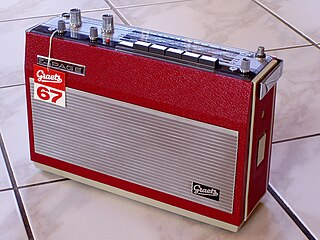Related Research Articles

Karlheinz Stockhausen was a German composer, widely acknowledged by critics as one of the most important but also controversial composers of the 20th and early 21st centuries. He is known for his groundbreaking work in electronic music, having been called the "father of electronic music", for introducing controlled chance into serial composition, and for musical spatialization.

In music, tape loops are loops of magnetic tape used to create repetitive, rhythmic musical patterns or dense layers of sound when played on a tape recorder. Originating in the 1940s with the work of Pierre Schaeffer, they were used among contemporary composers of 1950s and 1960s, such as Éliane Radigue, Steve Reich, Terry Riley, and Karlheinz Stockhausen, who used them to create phase patterns, rhythms, textures, and timbres. Popular music authors of 1960s and 1970s, particularly in psychedelic, progressive and ambient genres, used tape loops to accompany their music with innovative sound effects. In the 1980s, analog audio and tape loops with it gave way to digital audio and application of computers to generate and process sound.

Inori, for one or two soloists with orchestra, is a composition by Karlheinz Stockhausen, written in 1973–74.
Kreuzspiel (Crossplay) is a composition by Karlheinz Stockhausen written for oboe, bass clarinet, piano and four percussionists in 1951. It is assigned the number 1/7 in the composer's catalogue of works.

Momente (Moments) is a work by the German composer Karlheinz Stockhausen, written between 1962 and 1969, scored for solo soprano, four mixed choirs, and thirteen instrumentalists. A "cantata with radiophonic and theatrical overtones", it is described by the composer as "practically an opera of Mother Earth surrounded by her chicks". It was Stockhausen's first piece composed on principles of modular transposability, and his first musical form to be determined from categories of sensation or perception rather than by numerical units of musical terminology, which marks a significant change in the composer's musical approach from the abstract forms of the 1950s.

Kontakte is an electronic music work by Karlheinz Stockhausen, realized in 1958–60 at the Westdeutscher Rundfunk (WDR) electronic-music studio in Cologne with the assistance of Gottfried Michael Koenig. The score is Nr. 12 in the composer's catalogue of works, and is dedicated to Otto Tomek.
Sirius: eight-channel electronic music and trumpet, soprano, bass clarinet, and bass is a music-theatre composition by Karlheinz Stockhausen, composed between 1975 and 1977. It is Nr. 43 in the composer's catalogue of works, and lasts 96 minutes in performance.

Jubiläum (Jubilee) is an orchestral composition by Karlheinz Stockhausen, work-number 45 in the composer's catalogue of works.

Kurzwellen, for six players with shortwave radio receivers and live electronics, is a composition by Karlheinz Stockhausen, written in 1968. It is Number 25 in the catalog of the composer's works.

Musik im Bauch is a piece of scenic music for six percussionists and music boxes composed by Karlheinz Stockhausen in 1975, and is Number 41 in his catalog of works. The world premiere was presented on 28 March 1975 as part of the Royan Festival. The performance was given by Les Percussions de Strasbourg in the haras in the town of Saintes, near to Royan. Its duration is roughly 38 minutes.

Atmen gibt das Leben, is a choral opera with orchestra by Karlheinz Stockhausen, written in 1974 and expanded in 1976–77. It is Number 39 in the catalogue of the composer's works, and lasts about 50 minutes in performance.

Strahlen (Rays) for a percussionist and ten-channel sound recording is a composition by Karlheinz Stockhausen, and is Nr. 80½ in his catalog of works. Its performing duration is 35 minutes.
Formel (Formula) is a composition for chamber orchestra by Karlheinz Stockhausen, written while he was still a student in 1951. It is given the number 1⁄6 in his catalog of works, indicating that it is amongst the pieces preceding the composition he recognised as his first mature work, Nr. 1 Kontra-Punkte.

Stop is a composition for orchestra by Karlheinz Stockhausen, work-number 18 in the composer’s catalogue of works, where two performing realisations are also found as Nr. 18½ and Nr. 18⅔.

Ylem is a composition by Karlheinz Stockhausen for a variable ensemble of 19 or more players, and is given the work number 37 in his catalogue of compositions.

Sternklang, is "park music for five groups" composed in 1971 by Karlheinz Stockhausen, and bears the work number 34 in his catalogue of compositions. The score is dedicated to his spouse, Mary Bauermeister, and a performance of the work lasts from two-and-a-half to three hours.
Schlagtrio is a chamber-music work for piano and two timpanists composed by Karlheinz Stockhausen in 1952. It is Nr. ⅓ in his catalogue of works.

Plus-Minus, 2 × 7 pages for realisation, is a composition for one or several performers by Karlheinz Stockhausen, first written in 1963 and redrafted in 1974. It is Nr. 14 in the composer's catalogue of works, and has a variable performing length that depends on the version worked out from the given materials. The score is dedicated to Mary Bauermeister.
Drei Lieder, for alto voice and chamber orchestra, is a song cycle by Karlheinz Stockhausen, written while he was still a conservatory student in 1950. In the composer's catalogue of works, it bears the number 1/10.
"Choral" (Chorale) is a short a cappella choral composition by Karlheinz Stockhausen, who wrote both the words and music in 1950. It was later given the number 1/9 in the composer's catalogue of works and lasts about four minutes in performance. The score is dedicated to the composer's first wife, Doris Stockhausen, née Andreae.
References
- Griffiths, Paul. 2001. "Maconie, Robin (John)". The New Grove Dictionary of Music and Musicians , second edition, edited by Stanley Sadie and John Tyrrell. London: Macmillan.